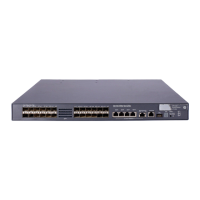111
To do… Use the command… Remarks
Enter Ethernet
interface view
interface interface-type interface-
number
Enter Layer 2
aggregate
interface view
interface bridge-aggregation
interface-number
2. Enter
interface
view
(including
Ethernet
interface
view,
Layer 2
aggregate
interface
view) or
port group
view
Enter port
group view
port-group manual port-group-
name
Required.
Use either command.
• In Ethernet interface view, the
subsequent configurations apply
to the current port.
• In port group view, the
subsequent configurations apply
to all ports in the port group.
• In Layer 2 aggregate interface
view, the subsequent
configurations apply to the Layer
2 aggregate interface and all its
member ports.
3. Configure the link type of the
ports as hybrid
port link-type hybrid Required.
4. Assign the hybrid ports to the
specified VLANs
port hybrid vlan vlan-id-list
{ tagged | untagged }
Required.
By default, a hybrid port allows only
packets of VLAN 1 to pass through
untagged.
5. Configure the default VLAN
of the hybrid port
port hybrid pvid vlan vlan-id
Optional.
VLAN 1 is the default by default.
To change the link type of a port from trunk to hybrid or vice versa, you must set the link type to access
first.
After you use the port link-type { access | hybrid | trunk } command to change the link type of an
interface, the loopback detection action configured on the interface with the loopback-detection action
command will be restored to the default. For more information about the loopback-detection action
command, see the Layer 2—LAN Switching Command Reference.
Before assigning a hybrid port to a VLAN, create the VLAN first.
After configuring the default VLAN for a hybrid port, you must use the port hybrid vlan command to
configure the hybrid port to allow packets from the default VLAN to pass through, so that the egress port
can forward packets from the default VLAN.
After you configure a command on a Layer 2 aggregate interface, the system starts applying the
configuration to the aggregate interface and its aggregation member ports. If the system fails to do that
on the aggregate interface, it stops applying the configuration to the aggregation member ports. If it fails
to do that on an aggregation member port, it skips the port and moves to the next port.
Port-based VLAN configuration example
Network requirements
As shown in Figure 37:
• Host A and Host C belong to Department A, and access the enterprise network through different
devices. Host B and Host D belong to Department B. They also access the enterprise network
through different devices.

